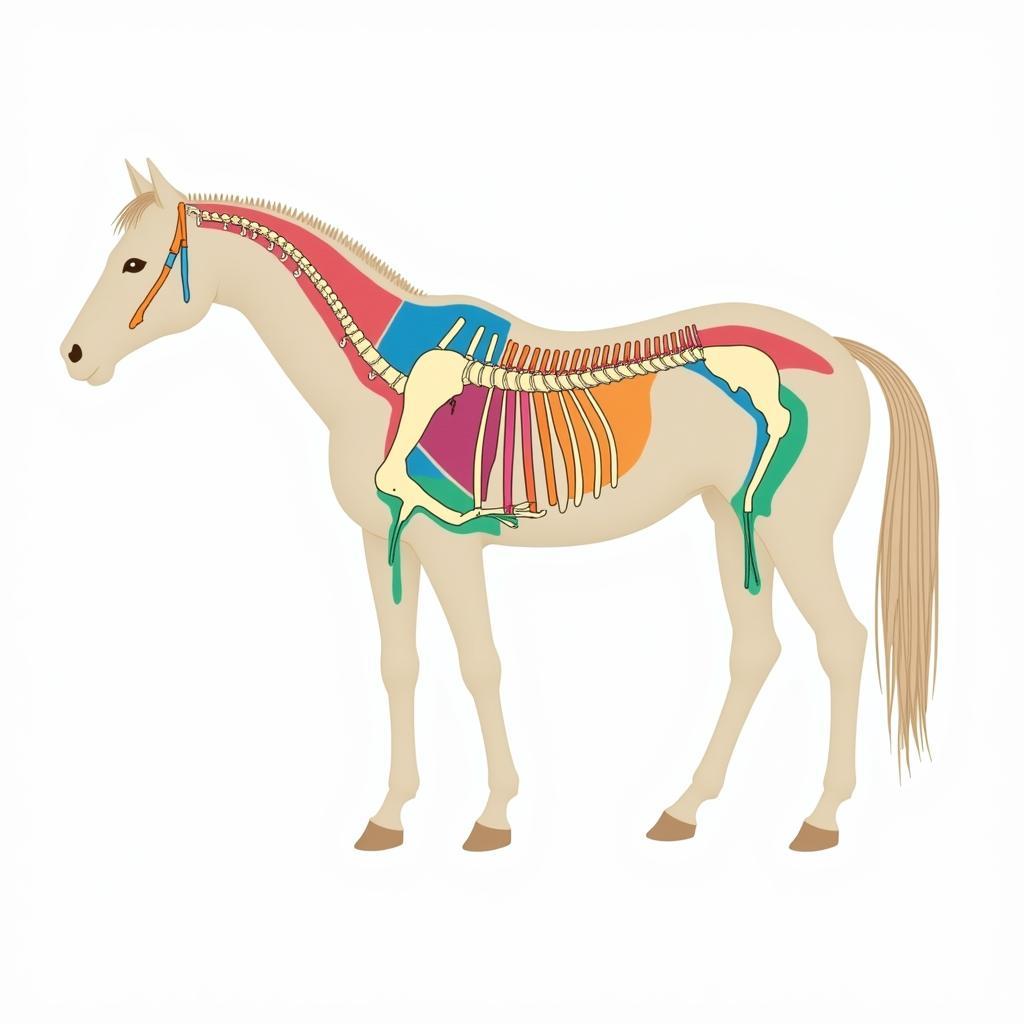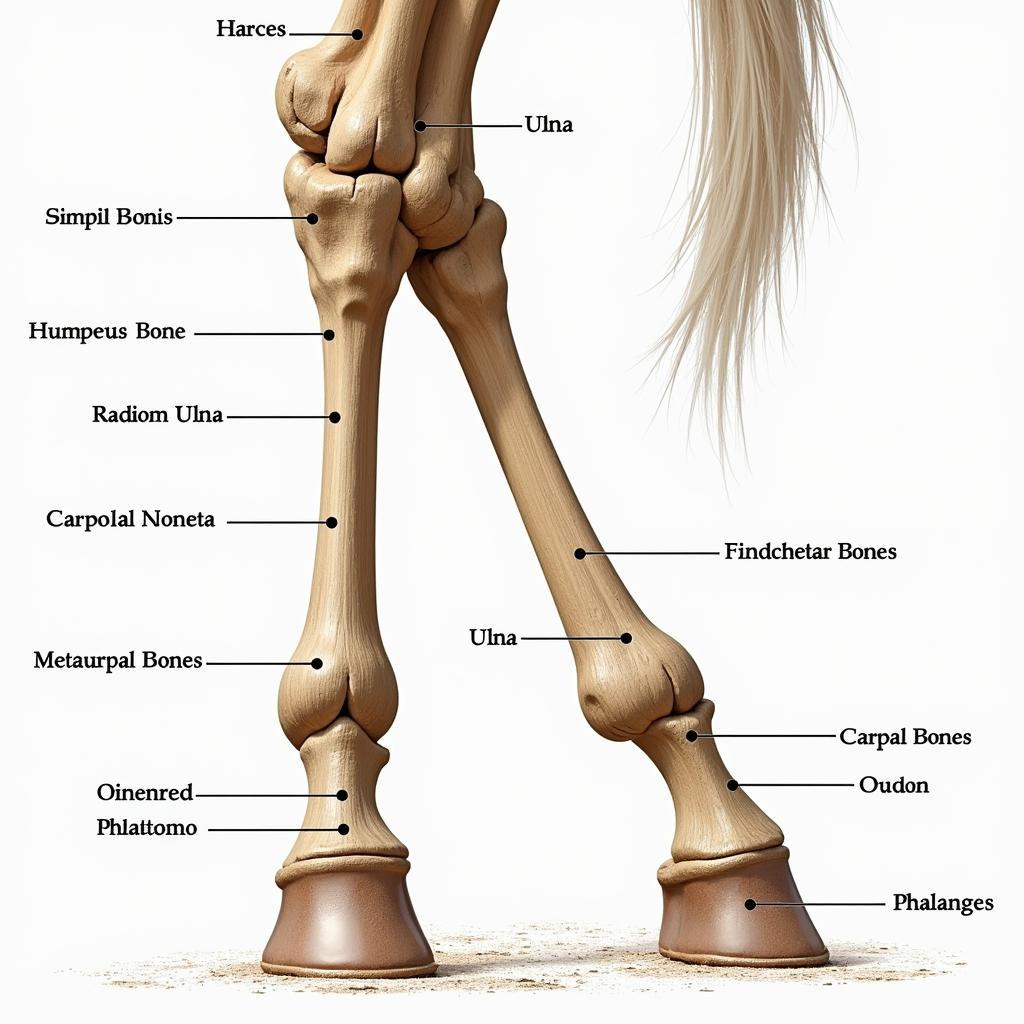The intricate framework of a horse’s bone structure is a marvel of natural engineering, perfectly designed for power, speed, and grace. Understanding Horse Bone Structure is crucial for any horse owner, allowing for better care, training, and recognizing potential health issues. This article will delve into the complexities of the equine skeleton, exploring its components, functions, and importance.
The equine skeleton comprises approximately 205 bones, categorized into the axial and appendicular skeletons. The axial skeleton forms the central axis of the body, including the skull, vertebral column, ribs, and sternum. It protects vital organs such as the brain, heart, and lungs. The appendicular skeleton consists of the limbs and the bones that connect them to the axial skeleton, facilitating movement and locomotion. A thorough knowledge of horse bone structure is essential for recognizing common ailments, like those that can be addressed with a horse ultrasound machine.
The Axial Skeleton: The Core of Horse Bone Structure
The skull, a complex structure housing the brain and supporting the facial features, is the cornerstone of the axial skeleton. The vertebral column, a series of interconnected bones, extends from the skull to the tail, providing support and flexibility. The ribs protect the thoracic cavity, housing the heart and lungs, while the sternum forms the floor of the chest.
Vertebral Column: The Backbone of the Horse
The vertebral column is divided into five regions: cervical, thoracic, lumbar, sacral, and coccygeal. The cervical vertebrae allow for neck movement, while the thoracic vertebrae support the ribs. The lumbar vertebrae, located in the lower back, are important for weight-bearing. The sacral vertebrae are fused to form the horse sacrum, a strong base for the hind limbs. Finally, the coccygeal vertebrae make up the tail. Knowing the specific roles of each section of the vertebral column can be especially helpful when assessing a 4 year old horse, as their skeletal development is still in progress.
 Regions of the Horse's Vertebral Column
Regions of the Horse's Vertebral Column
The Appendicular Skeleton: Enabling Movement and Agility
The appendicular skeleton, comprising the forelimbs and hind limbs, is critical for the horse’s movement. The forelimbs are attached to the body by a muscular sling, while the hind limbs are directly connected to the sacrum via the pelvic girdle. This unique bone structure allows for powerful propulsion and agility. Recognizing the relationship between the limbs and the axial skeleton is important when considering factors like how much weight can a quarter horse carry.
Forelimbs: Supporting and Cushioning the Horse
The forelimbs consist of the scapula, humerus, radius, ulna, carpal bones, metacarpal bones, and phalanges. The scapula, or shoulder blade, plays a crucial role in absorbing shock during locomotion. The humerus, radius, and ulna form the elbow joint and the forearm. The carpal bones, similar to the human wrist, provide flexibility. The metacarpal bones form the cannon bone, while the phalanges make up the pastern, fetlock, and hoof. Issues like horse hocks fusing can severely impact a horse’s mobility and require careful management.
 Bone Structure of the Horse's Forelimb
Bone Structure of the Horse's Forelimb
Conclusion: Horse Bone Structure – A Foundation for Health and Performance
Understanding horse bone structure is paramount for every equine enthusiast. From the skull to the hooves, each bone plays a crucial role in the horse’s movement, health, and overall well-being. By familiarizing yourself with the intricacies of horse bone structure, you can better care for your equine companion and appreciate the magnificent engineering of this remarkable animal.
Frequently Asked Questions
- How many bones are in a horse’s skeleton? Approximately 205.
- What are the two main divisions of the equine skeleton? Axial and appendicular.
- What is the function of the vertebral column? Support, flexibility, and protection of the spinal cord.
- What bones make up the horse’s forelimb? Scapula, humerus, radius, ulna, carpal bones, metacarpal bones, and phalanges.
- Why is understanding horse bone structure important? For better care, training, and recognizing potential health issues.
- How does the horse’s skeleton contribute to its movement? The specialized structure allows for powerful propulsion and agility.
- What are some common bone-related problems in horses? Fractures, arthritis, and developmental orthopedic diseases.
Need further assistance? Contact us at Phone: 0772127271, Email: [email protected] or visit us at QGM2+WX2, Vị Trung, Vị Thuỷ, Hậu Giang, Việt Nam. Our customer service team is available 24/7.